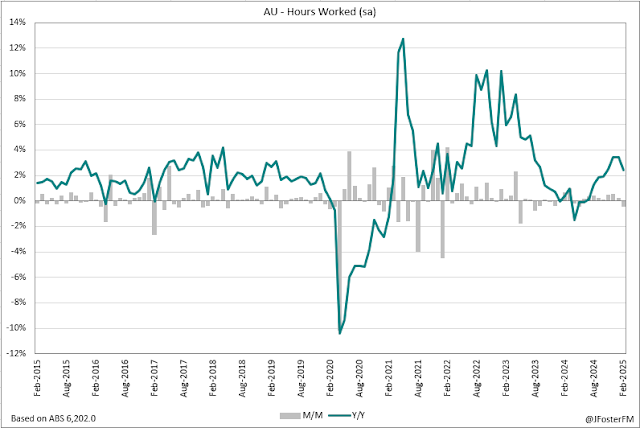Australia's labour force survey for March is due to come across the screens at 1130 (AEST) today. February saw a shock result with employment declining by almost 53k; however, with statistical noise at a heavy volume in that report, markets are looking for a rebound of 40k for March. A sizable fall in labour force participation from record highs helped keep the unemployment rate stable at 4.1% in February, but a reversal today could see it rise to 4.2%.
March preview: A return to normality expected
Seasonal volatility and a wave of retirements made for a noisy labour force report last time out, so today's figures for March should give a more settled read on conditions. That said, the disruptions caused by ex-Tropical Cyclone Alfred in early March were significant in south east Queensland and northern New South Wales, which may have some effect on the national snapshot.
In today's report, employment is expected to rise by 40k (range: 20-65k), rebounding from the shock 52.8k fall in February. My estimate for the previous report was for a 55k rise, so I will stick with that forecast on the view that the numbers will settle. The unemployment rate is anticipated to lift from 4.1% to 4.2% alongside a reversal of the large 0.4ppt decline in the participation rate seen in February to 66.8%.
February recap: Shock employment fall but unemployment rate holds at 4.1%
February's 52.8k decline in employment could hardly have come as a bigger shock with markets expecting a post-holiday rise of 30k driven by workers moving into new roles. Employment in both segments declined: full time -35.7k and part time -17k. This was the weakest monthly read on employment since December 2023, with the ABS's release note highlighting the impact of a wave of retirements coming into effect early in the new year.
Consistent with increased retirements, a sharp retracement was reported in the participation rate to 66.8%, down from record highs of 67.2% in the prior month. As a result, the unemployment rate held at 4.1% - despite the large fall in employment. Adding to the noise in the report, broader measures of spare capacity in the labour market declined in February: underemployment 6% to 5.9% and underutilisation 10.1% to 9.9%.
Hours worked fell by 0.4% in February - perhaps an even greater surprise than the employment result given hours typically rebound after falling through the peak summer holiday period in January. On this occasion, January hours were revised to a 0.2% lift from a 0.4% decline reported initially. Base effects saw annual growth slow from 3.5% to 2.4%.




